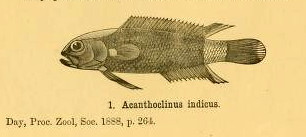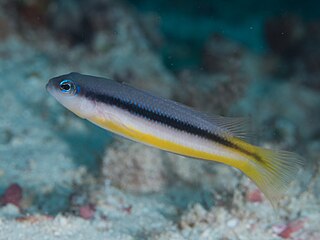Collared wrigglers are perciform fishes in the family Xenisthmidae. They are native to the Indian and Pacific Oceans, where they are mostly reef-dwelling.

The dottybacks are a family, Pseudochromidae, of fishes which were formerly classified in the order Perciformes, but this has been revised and the family is regarded as of uncertain affinities, or incertae sedis within the Ovalentaria, a clade within the Percomorpha. Around 152 species belong to this family.
Pseudoplesiops wassi, the fleckfin dottyback or Wass's dottyback, is a species of dottyback fish. It is found associated with coral reefs and other rocky coastal habitats in a large part of the south-western Pacific including the Great Barrier Reef, the Coral Sea, the Caroline Islands, the Bismarck Archipelago, Vanuatu, Fiji, Rotuma, Tonga, Samoa, and the Solomon Islands. The specific name honours the fisheries biologist Richard C. Wass.

Pseudochromis is a genus of fish in the family Pseudochromidae found in Indian and Pacific Ocean.

Acanthoplesiops is a genus of reef-dwelling fishes belonging to the family Plesiopidae. All species are very small, with the largest specimen recorded only reaching 27 mm standard length. They have several features which distinguish them from other plesiopids, the most obvious of which is the presence of one or two spines on the operculum.

Pseudochrominae is a subfamily of ray-finned fishes, one of four subfamilies that make up the family Pseudochromidae, the species within the subfamily are commonly called dottybacks. They are small reef-associated marine fish which have an Indo-Pacific distribution.

Manonichthys is a genus of ray-finned fishes from the subfamily Pseudochrominae, which is one of four subfamilies in the dottyback family Pseudochromidae. They are found in the tropical eastern Indian Ocean and the western Pacific Ocean. Many of the species of Manonichthys live within the bodies of large sponges, the genus name references the Greek word for a kind of sponge, manon, in combination with the Greek word for "fish", ichthys.
Pholidochromis is a genus of ray-finned fishes from the subfamily Pseudochrominae, which is one of four subfamilies in the dottyback family Pseudochromidae. They occur in the western and central Pacific Ocean.

Pictichromis is a genus of ray-finned fishes from the subfamily Pseudochrominae, which is one of four subfamilies in the dottyback family Pseudochromidae. They occur in the western and central Pacific Ocean.
Pseudoplesiopinae is a subfamily of the family Pseudochromidae, the dottybacks, it consists of small species of coral-reef inhabiting fish which are distributed throughout the Indo-Pacific.
Chlidichthys is a genus of ray-finned fishes from the western and central Indian Ocean, it is part of the subfamily Pseudoplesiopinae which in turn is a constituent subfamily of the dottyback family, the Pseudochromidae. Within the Pseudoplesiopinae, Chlidichthys is regarded as a sister taxon to Pectinochromis.
Lubbockichthys is a genus of ray-finned fish from the Indo-Pacific region which belongs to the subfamily Pseudoplesiopinae, part of the family Pseudochromidae, the dottybacks. The species in this genus have small cycloid scales throughout their lives; some of their head bones have a weakly honeycombed surface; and the parietal bone encloses the rear section of the supratemporal laterosensory canal.
The ocellate soapfish is a species of marine ray-finned fish with a wide Indo-Pacific distribution. It is the only species in the genus Grammistops. It is also known as the ocellated soapfish, ocellated podge, or false-eyed soapfish. The specific name ocellatus refers to the ocellate (eye-like) spot on the operculum.
Chlidichthys abruptus, or St Brandon's dottyback, is a species of fish in the family Pseudochromidae.
Chlidichthys chagosensis, the Chagos dottyback, is a species of fish in the family Pseudochromidae.
Chlidichthys foudioides, the Fody dottyback, is a species of fish in the family Pseudochromidae.
Pseudochromis kristinae, the lip-stick dottyback, is a species of ray-finned fish from the Western Indian Ocean: along East Africa, around the island of Madagascar and the Comoro Islands, which is a member of the family Pseudochromidae. This species reaches a length of 4.6 cm (1.8 in).
Pseudochromis melanurus, the black-tail dottyback, is a species of ray-finned fish from Tonga and Fiji in the Pacific Ocean, which is a member of the family Pseudochromidae. This species reaches a length of 4.0 cm (1.6 in).

Pseudochromis ammeri the Raja Ampat dottyback, is a species of ray-finned fish from the Pacific Ocean around Indonesia, which is a member of the family Pseudochromidae. This species reaches a length of 6.0 cm (2.4 in).
Pseudochromis striatus, the striated dottyback, is a species of ray-finned fish from the Western Pacific, including the Philippines, Taiwan and Ryukyu Islands, which is a member of the family Pseudochromidae. This species reaches a length of 3.2 cm (1.3 in).





